
Picnic - Icarian, Verona, July 12, 1925 [Akron visitors, including Sarantos & Jim Pastis, Gust Herouvis, Kalliope Pastis,Vassiliki Pastis Herouvis (Gust & Vivian Pastis)]
PITTSBURGH AND VERONA
Most early 19th century Icarian immigrants entered the US via the Ellis Island immigrant processing center in New York Harbor. According to ship manifest records, some stayed in New York, but the large majority listed the Pittsburgh area as their final destination, with many of them settling in the nearby borough of Verona. Early Icarian settlers in Pittsburgh started out as laborers and painters in the city’s numerous factories and railroad yards. Most did not intend to make America their permanent home. Their goal was to save up enough money for a better life in Icaria. A few became shopkeepers and merchants providing goods and services to other immigrants. Some became contractors, hiring and recruiting other immigrants to take on large industrial maintenance jobs.
ICARIAN BROTHERHOOD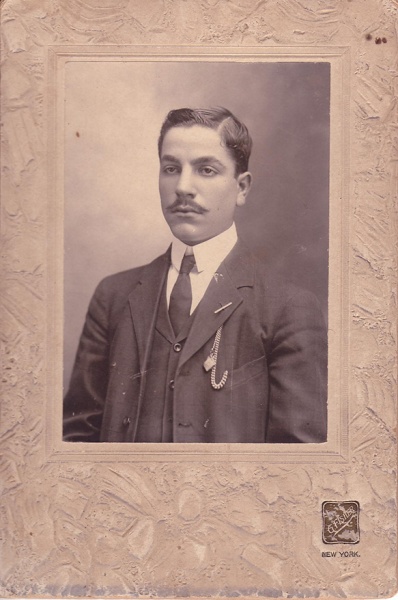 According to Icarian-American lore, eleven Icarian men from the Pittsburgh area met in 1903 for the purpose of forming an organization to preserve their Icarian identity and offer assistance to their fellow islanders. Those who attended and founded this Brotherhood are: Demetrios Vassilaros, Vasilios Triantafillou, John Pamphilis, Stamatis Kratsas, Emmanuel Pamphilis, Nikolaos Vassilaros, Angelo Tsantes, Anastasios Diniacos, John Lardas, Nicholas Paralemos, and John Mavrikes.
According to Icarian-American lore, eleven Icarian men from the Pittsburgh area met in 1903 for the purpose of forming an organization to preserve their Icarian identity and offer assistance to their fellow islanders. Those who attended and founded this Brotherhood are: Demetrios Vassilaros, Vasilios Triantafillou, John Pamphilis, Stamatis Kratsas, Emmanuel Pamphilis, Nikolaos Vassilaros, Angelo Tsantes, Anastasios Diniacos, John Lardas, Nicholas Paralemos, and John Mavrikes.
One of the first acts of charity of the new group was to help with funeral expenses for an Icarian immigrant named Ioannis Lefes. Mr. Lefes was a 33-year-old painter who was killed in May 1904 in an industrial accident, while painting at a steel mill owned by US Steel. His widow and orphaned children were on Icaria and if not for the Icarians in Pittsburgh he would have died alone. The committee arranged for a proper Orthodox funeral although, a Russian priest had to do the service since there were no Greek priests in Pittsburgh at that time.
The 1904 death of Ioannis Lefes, underscored the need for a formalized mutual aid society. In 1905, the Icarian Brotherhood of America “Icaros” was chartered by the Allegheny County Court of Pennsylvania in the city of Pittsburgh. In addition to reinforcing Icarian ties in America, the new organization was chartered to assist and extend financial aid to sick and disabled members and help pay for funeral expenses. The Brotherhood would also attempt to undo centuries of Turkish neglect by aiding in the construction of needed projects for its members’ isolated homeland. American Icarians even responded to Icaria’s 1912 revolution against the Turks by sending guns, ammunition, money and volunteers.
ARTEMIS AND ICAROS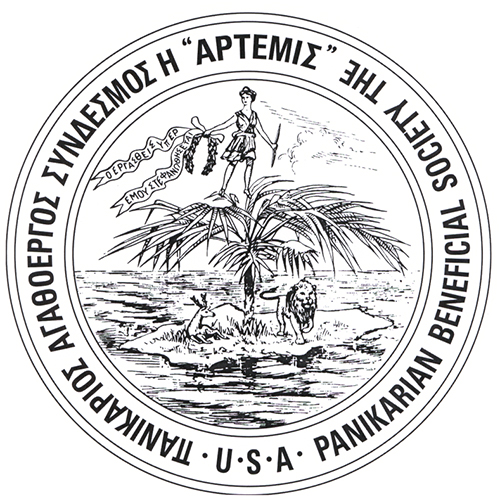 Unfortunately, disagreements developed between members from the northern and southern parts of Icaria regarding which parts of the island should benefit from the Brotherhood’s philanthropy. Northern Icarians in the Pittsburgh area formed the Pan-Ikarian Beneficial Society “Artemis” (in reference to the ancient temple of the goddess Artemis on Icaria’s northwest coast) and the organization was officially chartered in 1910. A main concern of the “Artemis” group was the construction of a harbor at the northern seaport of Evdilos while the “Icaros” club focused its attentions on building a high school in the southern town of Ayios Kyrikos. The formation of the Artemis Society did not hamper the raising of almost $49,000 by 1925 for construction of the high school.
Unfortunately, disagreements developed between members from the northern and southern parts of Icaria regarding which parts of the island should benefit from the Brotherhood’s philanthropy. Northern Icarians in the Pittsburgh area formed the Pan-Ikarian Beneficial Society “Artemis” (in reference to the ancient temple of the goddess Artemis on Icaria’s northwest coast) and the organization was officially chartered in 1910. A main concern of the “Artemis” group was the construction of a harbor at the northern seaport of Evdilos while the “Icaros” club focused its attentions on building a high school in the southern town of Ayios Kyrikos. The formation of the Artemis Society did not hamper the raising of almost $49,000 by 1925 for construction of the high school.
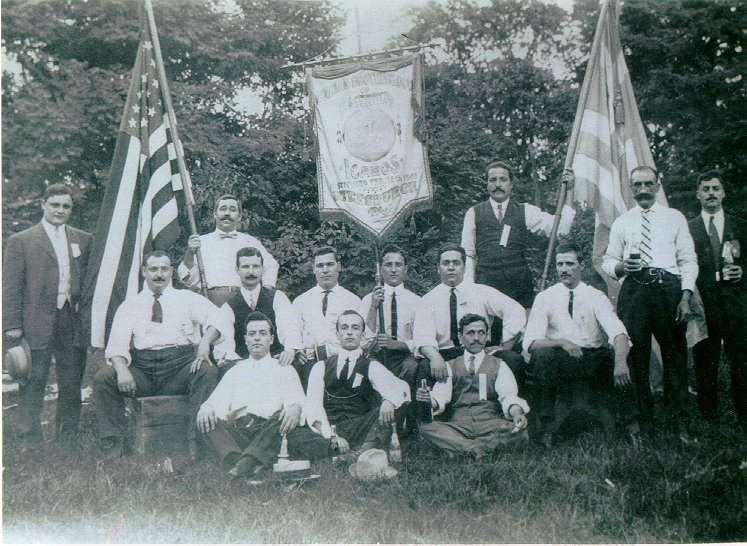
Early 1900's Pittsburgh Icarian Picnic
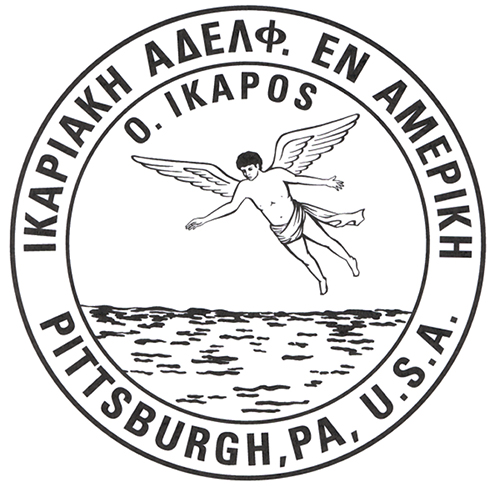 Both the Artemis and Icaros groups held large annual summer picnics in the countryside near Pittsburgh attracting hundreds of participants. Efforts were made to unite the two groups and occasionally joint picnics were held.
Both the Artemis and Icaros groups held large annual summer picnics in the countryside near Pittsburgh attracting hundreds of participants. Efforts were made to unite the two groups and occasionally joint picnics were held.
Both the “Icaros” and “Artemis” of Pittsburgh functioned as insurance companies whose ability to provide medical and disability benefits depended on attracting dues paying members. Dues were like insurance premiums and the financial wellbeing of the club depended on spreading the fiduciary risks amongst a large base of members. The clubs did not want to dilute their financial base by encouraging new chapters in other parts of the country which would probably not want to relinquish control of their treasuries to a central organization in Pittsburgh. The Icaros club dealt with the need to expand its members while keeping control of the assets by sending agents to outlying Icarian communities to recruit new dues paying members.
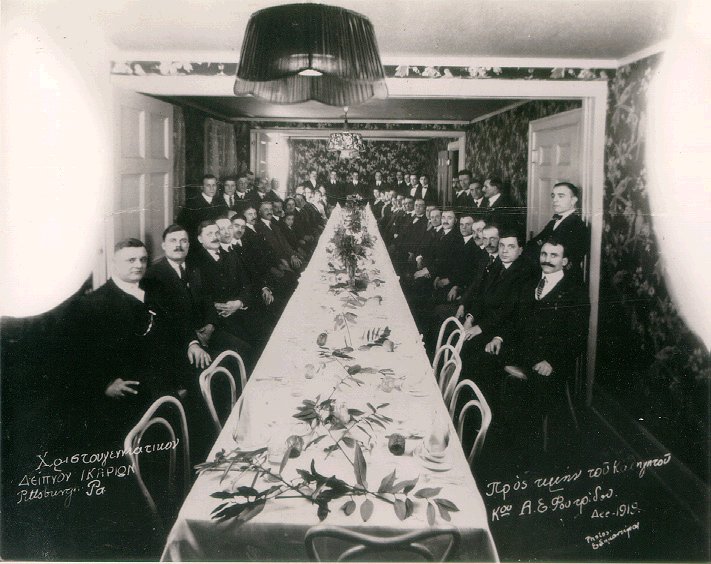
Icarian Christmas Dinner - 1919
V. I. CHEBITHES
The model for a national Icarian organization came from the AHEPA (American Hellenic Educational Progressive Association), which was founded in Atlanta, Georgia in 1922. AHEPA’s structure was itself based on that of other American national fraternal organizations. By 1925 an American educated Icarian attorney, Vasilios Isidoros Chebithes, was using his brilliant organizational and public relations skills with his dynamic speaking ability to establish new AHEPA chapters, expanding it into the largest Hellenic organization in the United States. Prior to Chebithes’ involvement AHEPA was on the verge of bankruptcy and collapse. Chebithes was able to attract many Icarians into the growing organization. Exposure to a well-run national pan-Hellenic organization inspired interest among Icarians to develop a similar national organization to unite all Icarians in the US.
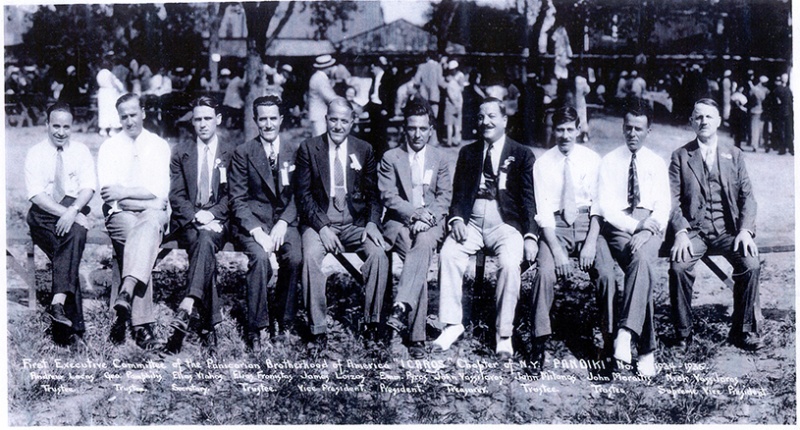
New York - Pandiki - 1934-35 - Executive Committee
YOUNGSTOWN 1934
Since the Icarian Brotherhood was reluctant to relinquish control of its assets to a national organization and its by-laws made no provision for establishing chapters outside of Allegheny County, V. I. Chebithes decided to bypass the objections of the Pittsburgh group and create an entirely new organization. In 1931 Chebithes organized the Icarians of Akron, Ohio into the Knights and Ladies of Icaria which had the acronym KALOI (meaning “the righteous” in Greek). By 1934 there were 350 members spread among chapters in Gary, Indiana; New York City, and the five Ohio cities of Akron, Cleveland, Warren, Steubenville, and Youngstown. A meeting of the KALOI, Icaros, and Artemis groups was held in Youngstown, Ohio for the purpose of creating a united, national Icarian organization. The “Pan-Icarian Brotherhood” emerged from a merger of the Icarian Brotherhood of Pittsburgh with the various chapters of the KALOI. The Artemis Society, though still an Icarian organization, had evolved into a private social club which operated a bar and was open to non-Icarian, non-voting members making it incompatible with the new Pan-Icarian Brotherhood.
PAN-ICARIAN BROTHERHOOD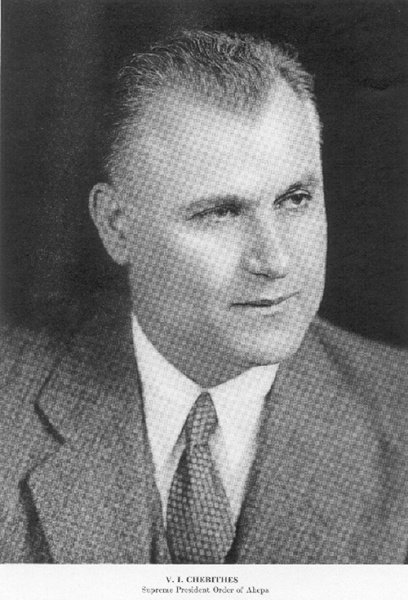 The structure of the Pan-Icarian Brotherhood would be similar to AHEPA and other American fraternal organizations. Members paid dues to local chapters and the national organization was run by a national governing body or “supreme lodge” elected at annual conventions. A constitution drafted in 1935 stated that membership would be open to any Icarian or Fournian (from the neighboring island), regardless of sex, and their spouses and children. Although the constitution made general references to assisting its members in “times of sickness and death” it also emphasized providing “a place where its members may enjoy the society of each other and their friends”.
The structure of the Pan-Icarian Brotherhood would be similar to AHEPA and other American fraternal organizations. Members paid dues to local chapters and the national organization was run by a national governing body or “supreme lodge” elected at annual conventions. A constitution drafted in 1935 stated that membership would be open to any Icarian or Fournian (from the neighboring island), regardless of sex, and their spouses and children. Although the constitution made general references to assisting its members in “times of sickness and death” it also emphasized providing “a place where its members may enjoy the society of each other and their friends”.
The Brotherhood provided an early training ground for Icarians to assume leadership roles in the Greek-American community. Icarians played a major role in AHEPA’s effort to send more that $5,000,000 in food and supplies to Greece in the seven months following the 1940 Axis invasion and were well represented on the AHEPA Justice for Greece Committee, which fought for a fair settlement of Greece’s postwar territorial claims.
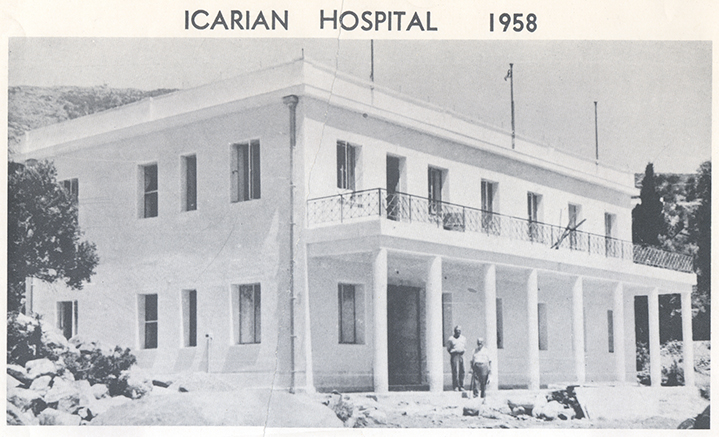
After World War II and the ensuing civil war in Greece, Icarian-Americans sent thousands of dollars to their beleaguered island as part of the Icarian War Reconstruction Fund. By 1959, Pan-Icarian contributions built the island’s first hospital. Realizing a need to better organize its numerous philanthropic endeavors, the Brotherhood created the Pan-Icarian Foundation in 1965. The Foundation was established to keep money in an irrevocable trust administered by a committee who can only release money for charitable, cultural, educational, or religious purposes. Over the years hundreds of thousands of dollars having been disbursed to provide medical assistance, college scholarships, as well as financial relief for victims of natural disasters in the US and Greece.
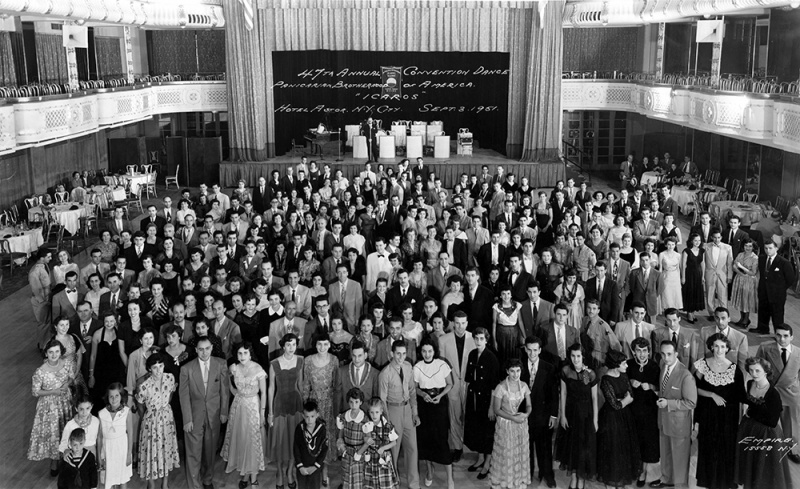
47th Dance
Annual conventions started in 1935 and were held during Thanksgiving weekend until 1938. Due to inclement weather, they moved to Labor Day weekend beginning in 1939 and resumed on a regular basis after WWII. The conventions which are likened to huge “family reunions” with business sessions, dances, tours, and cultural events attract 1,000 to over 2,000 participants. Currently there are 25 active chapters in the United States including two in Canada with a combined dues paying membership near 2,000.
A large part of the membership is now linked via the Internet through the national website, Pan-Icarian.com and Social Media (Facebook, Twitter & Instagram). The entire membership is connected through three to four issues of Ikaria magazine per year whose antecedents date back to the Ikaros newspaper from the 1920s. This well crafted, comprehensive publication covers chapter news and announcements of births, deaths, weddings, and baptisms. In addition the magazine reports on the business of the national officers and Pan-Icarian Foundation, minutes of national conventions and the myriad activities of Icarians throughout the world.
The adaptability of the Pan-Icarian Brotherhood has allowed it to thrive for over a hundred years while hundreds of similar organizations have died out. It changed as the needs and demographics of its members changed. In the early 1900s it was a mutual aid society to help immigrant men and to assist in the development of the island. As families grew, social activities were added and today the organization offers a way for second, third, and fourth generation Greek-Americans to connect to their heritage. All Icarians are literally one large extended family and their creativity in accommodating the needs of the Icarian diaspora will ensure a successful Brotherhood for many years to come.
Nikitas J. Tripodes
We thank Panicarian Brotherhood of America for the granting us the material used in the artical.
ikariamag.gr








